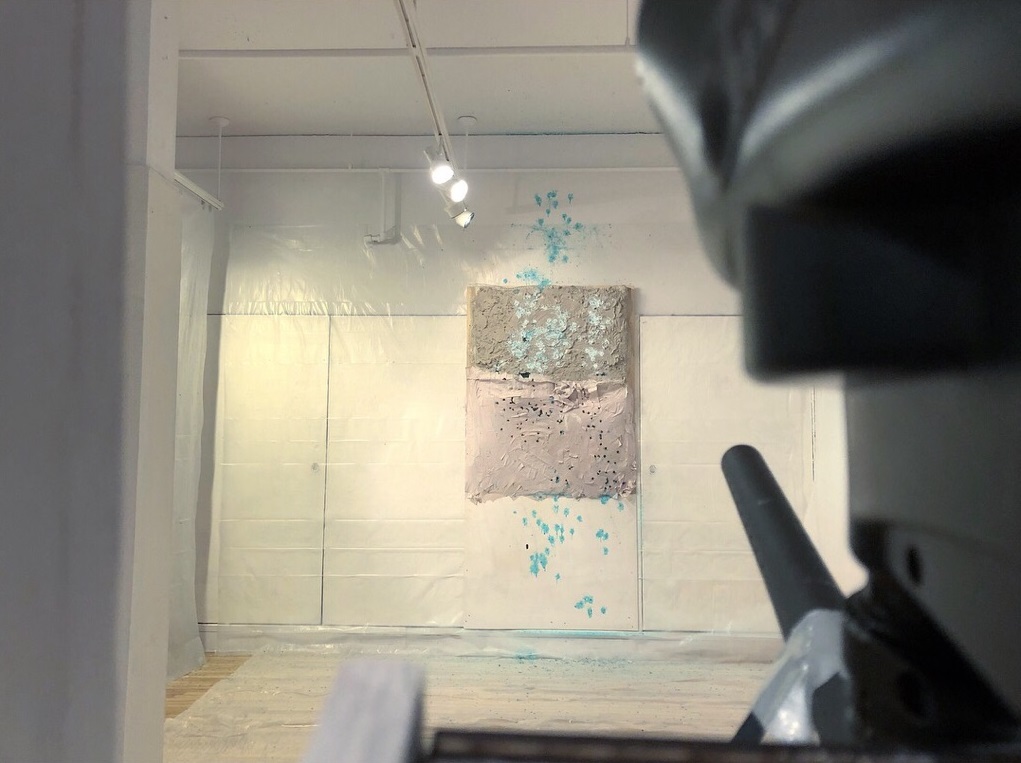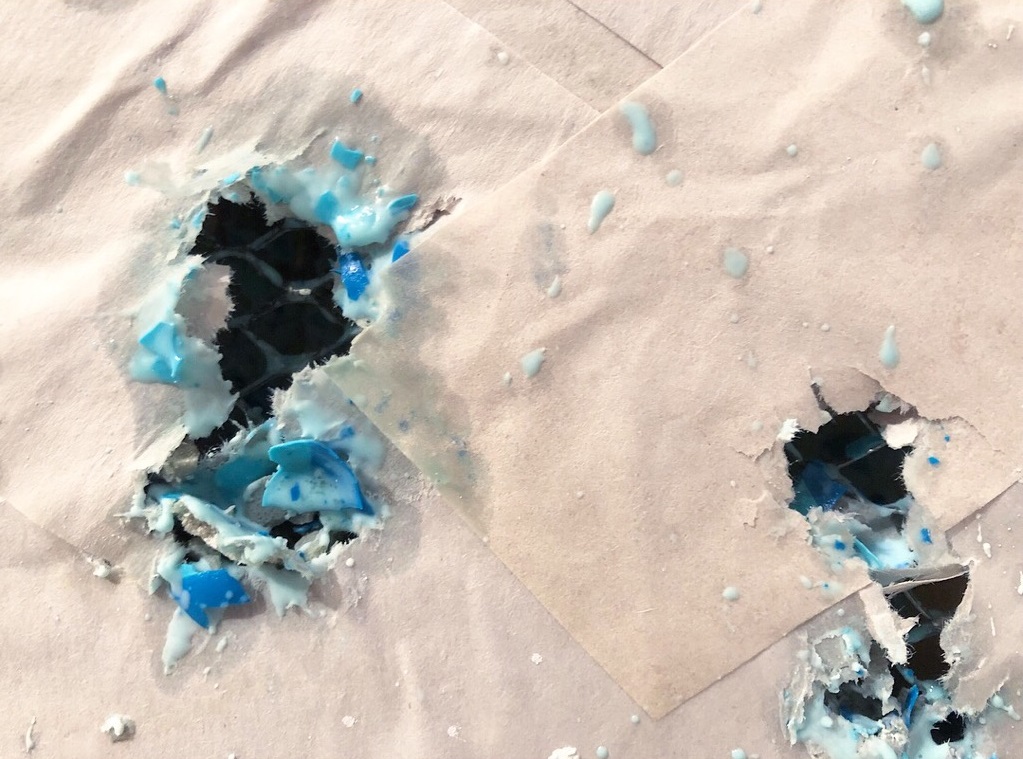Shannon Case, Travis Chambers, & Brandon Darreff

Title: “What Do You Think of Me?”
Narrative:
With this piece we hoped to draw attention to the unproductive discussion on gun control which has continued to dominate the U.S. political environment for the past several years. The user was prompted to speak into a microphone with the question “What Do You Think of Me?” in relation to the presence of a visible paintball gun. Their speech triggered the marker to start firing blue paintballs at a 4’x8’ canvas, oriented vertically, causing the noise of rapid fire to overpower their voice.
The canvas was divided into three material portions; a hard, wooden section, a layer constructed from paper-mache, and a section with plaster applied over mesh. As the user increased their volume to try and overpower the gun, the firing was intended to move vertically along the y-axis and subsequently start hitting the more fragile portions of the canvas. The resulting deterioration of the canvas was be representative of how the shouting match between the two sides of this larger debate is unproductive and more destructive if anything, represented by the resulting accumulation of debris on the floor below the canvas.






Course Themes:
With this project we developed an installation which generates a narrative even before robotic manipulation is employed; the mounted gun and intentional bold provocative text elevate the story line to a heightened level of discomfort for the user, allowing the physical movement and percussiveness of gunfire to be that much more of a surprise during the performance. The resulting canvas artifact makes just as much of a statement as the mounted marker itself with the visible presence of bullet holes and splattered color showing how the artifact and device in robotic sculpture can contribute equally to the project’s effect.
We implemented autonomy in the way the marker operates independently of physical interaction. This decision contributes to the overall concept of the project which is very much focused on the vocal battle and power struggle between the user and the machine.
Outcomes:
Overall, we saw the final demonstration as a success. The robot took input from the users speaking into a microphone which was mapped to an x and y position based off of the volume at which the person spoke. Initially we had problems setting up due to missing parts but were able fully assemble the gun and fully demonstrate the robot.
Our narrative called for 3 different materials on the canvas that would behave differently when struck by a paintball. The bottom was the made of plywood where the paintballs would simply break, the middle was made of paper mache where the paintballs would break through the paper mache, and finally plaster at the top which would chip and shatter. We did this to demonstrate how the gun control conversation become more destructive as volume significant than content. The canvas ended up being a success for us as the paintballs not only behaved differently on initial impact but also dried differently which further emphasized our desired effect.
Originally we planned to use a second mic to pick up the sounds of the paintball marker and a speaker to playback the marker sound forcing the user to speak louder. This turned out to be unnecessary as the marker itself was loud enough to drown out the voice of the person. The concussive sound of both the marker firing and paintballs hitting the canvas not only served the purpose of forcing the speaker to talk louder but also gave the demonstration a palpable auditory impression.
The greatest struggle we had during the final demonstration was the center of gravity of the marker. The center of gravity of the marker was a problem for us throughout the semester, originally we had measured the center of gravity without the co2 tank or a hopper. When the tank was added the marker tilted up because it was too back-heavy so a counter balance was added to the barrel to offset the weight. The addition of a full hopper meant the counter balance needed to be lighter but also added a new problem. As the marker fired and the hopper emptied, the center of gravity shifted back again. This change in center of gravity made it difficult for the motors to move the marker forward causing the marker to fire above the canvas. If we were to build this robot again, trying to find a more accurate center of gravity earlier would have helped but we would still have needed to find a way to account for the changing weight in the hopper. It is possible that springs or bungees could have helped but that was a problem that would have needed to be discovered earlier for the best solution to be implemented.
Timing was our main struggle. From building to the performance, better management of our time would have helped us solve problems. If we had the chance to debug the earlier in the process we might have caught some of our issues earlier and would have had a more polished final demonstration.
Related Work:
Wafaa Bilal’s Shoot an Iraqi
http://wafaabilal.com/shoot-an-iraqi/
https://www.youtube.com/watch?v=DcyquvDEe0o
Whitney Bandel
Sam Durant’s Dark Institutions
http://www.artnet.com/WebServices/images/ll510618llgpGfDrCWBHBAD/sam-durant-dark-institutions.jpg
Nikki Saint Phalle
http://www.tate.org.uk/art/artworks/saint-phalle-shooting-picture-t03824
https://www.youtube.com/watch?v=s5MUxuY4Hbw&vl=en
http://walkerart.org/collections/publications/art-expanded/pop-gun/
Member Contributions:
Shannon: Video Documentation and editing throughout project, p5.js code, branding design/vinyl cutting, canvas assembly, final assembly
Travis: Arduino code, electronics/motor coordination and implementation, canvas assembly, final assembly
Brandon: CAD Design, fabrication of parts (pulleys, motor plates, marker clamp, etc.), woodshop construction, canvas assembly, final assembly
Technical Documentation:
Comments are closed.